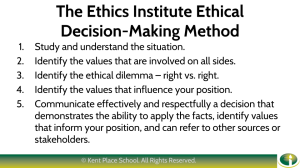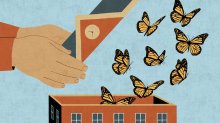Innovative Ways to Make Coronavirus a Teachable Moment
When the world feels dangerous, harnessing learning can provide some measure of clarity and perspective.
Your content has been saved!
Go to My Saved Content.The massive public health challenge of Covid-19, in spite of its many unknowns, offers teachers the unique instructional opportunity to tap into students’ innate curiosity about the virus and deliver lessons that are timely, prompt kids to dig deep, and—ideally—provide a modicum of comfort during a time of alarming headlines and copious misinformation.
From simple concepts that work well for younger kids—like why hygiene matters and how germs spread—to more complex topics like ethical decision-making, the science behind how viral infections work, or the mathematics underpinning pandemics—teachers are finding ways to help kids rise above the noise with unique, thoughtful lessons.
THE MATH BEHIND PANDEMICS
Math, often considered a strictly rational discipline, can play an important emotional and psychological role during uncertain times, giving students productive tools to battle fear and misinformation.
Frank Wang, a math teacher and the president of Oklahoma School of Science and Mathematics, began teaching kids the math of epidemics during a summer program he taught in 2010 to students from Clark County, Nevada. At the time, it seemed like a lively way to make math more compelling to the middle school students enrolled in the program. Now, he’s showcasing some of that content on Facebook and providing resources for middle and high school students to grapple with the mathematics behind how an epidemic grows and spreads.
“What’s unfolding is a catastrophe, but it’s also a time to share rich math and teach about the concepts of calculus—the mathematics of change. For young people, it can be a way to motivate their learning of mathematics,” says Wang. “Where teaching about exponential growth might have them scratching their heads in the classroom, now we can show that these models are being used in hospitals to calculate things like: how many ventilators, or how many hospital beds, will they need?”
In one scenario, Wang uses the Las Vegas strip as ground zero for a worldwide epidemic. “Forty million people visit that little patch of land. They stay a couple days and then go back home,” says Wang. “Kids can play around with these models and change the parameters—like the incubation period or mortality rate.”
VIROLOGY AND BIOLOGY
Students in anatomy and physiology teacher Scott Johnson’s class at Century High School in Bismarck, North Dakota, already completed a unit on virology, so for an upcoming lesson on the respiratory system, he plans to have his students examine an article about how the coronavirus impacts the body in an effort to provide what the National Science Teaching Association calls 3D Learning—a scaffolding of learning that more closely reflects real-life scientific inquiry.
“Johnson’s goal isn’t to limit the discussion to the unit he’s covering, but rather to find ways to explore a wider lens and encourage deeper learning,” writes Stephen Noonoo for EdSurge. “He asks students to evaluate the sources of information they’re reading and, where possible, gets them to think about how other disciplines, such as biology or the social sciences, are involved. The idea is to get students to think like scientists and consider the sequence of questions that need to be asked and answered in order to make sense of the virus.”
JOURNALISM
Teaching students to become storytellers—to find and tell the unique stories that exist as a result of living through the pandemic, accurately and compellingly—is a powerful learning experience that not only helps prepare kids to become civically engaged, productive adults, but also to process the extreme changes they’re coping with as a result of coronavirus.
“For teenagers, every day is an entire period in their lives—so much happens in one day, in one moment. So they’re feeling this in ways we don’t understand as adults,” says Leah Clapman, managing editor and founder of PBS NewsHour Student Reporting Labs. “So what we’re seeing is a real reckoning with that, they’re thinking through it. And being able to express themselves by making videos—not just for their friends, but for people outside of that space—is really powerful and allows them to explain what that feels like."
The PBS unit, which runs labs in 150 schools teaching students video journalism, offers a free curriculum called Making Sense of Coronavirus that helps teachers get started on teaching students to cover the basics of local video journalism from their homes.
MAKERS OF HISTORY
When teachers ask students to journal—in writing, sketches, videos, or other forms of expression—they are harnessing a powerful tool for providing an outlet for kids’ feelings. At the same time, journaling allows students to create a record of their daily lives at a time when the new normal stands in stark contrast to life even just one month ago.
“When future historians look to write the story of life during coronavirus, these first-person accounts may prove useful,” writes Amelia Nierenberg for The New York Times. “History isn’t usually told by the bigwigs of the era, even if they are some of its main characters. Instead, it is often reconstructed from snapshots of ordinary lives.”
Bryan Shaw, a social studies teacher at Ygnacio Valley High School in Concord, California, created a Covid-19 Student Journal assignment—a simple one-pager that provides guidance for students to record changes in their communities, in the country, and the world at large, and then asks them to critically analyze it and develop their own interpretations. The document recently went viral and has been adapted into ten versions in at least four languages, says Shaw.
“I’ve always been interested in rethinking history curriculum: how can we make it interesting?,” says Shaw. “At least 85 percent of my students are on Free and Reduced Lunch and so there are real Wi-Fi access issues, and I’m not a fan of too much learning on a computer. So this is something kids can do without a computer, a way to think about what’s going on in my family, my neighborhood, the world around me.”
ASKING HARD ETHICAL QUESTIONS
Now that students around the world are grappling with the realities of life during a pandemic, there is ample opportunity for teachers to fold current events into lessons and provide opportunities—especially for middle and high school age kids—for debate and critical thinking. When done well, writes Linda Flanagan for KQED, these may open the door for students to experience empathy, self-reflection, and even personal growth.
For example, teachers might take on the news reports from Italy where doctors, facing an overburdened healthcare system in the Northern part of the country, must decide which patients stand a better chance of surviving—and then deny care to the sickest. With this type of sensitive topic, teachers might give students the opportunity to opt out, or pick another subject, such as exploring the digital divide and reflecting on the social justice issues that it raises.
The following framework, used by teachers at the Ethics Institute at Kent Place School in New Jersey, is used with middle and high school students to begin exploring a set of values and applying a framework for ethical decision-making.

MEDIA LITERACY
Teachers can play an important part in improving students’ skills at determining what’s true and what isn’t when it comes to online information, especially now, when online hoaxes abound.
In a 2016 study, Stanford education and history professor Sam Wineburg and a team of researchers surveyed nearly 8,000 students across 12 states and concluded that: “Overall, young people’s ability to reason about the information on the Internet can be summed up in one word: ‘bleak’,” Wineburg wrote.
Students need to learn how to evaluate sources on their own, and the best way to do that is to teach them to think like professional fact-checkers. In a piece for Education Week, Wineburg noted three guiding principles teachers can tap into when teaching media literacy:
Read laterally: While students tend to read vertically, fact-checkers read laterally, Wineburg writes, leaving the original page to open up new tabs and read more deeply from other sources, and dig into other ways to verify a story.
Don’t trust the ‘about’ section: Fact-checkers never evaluate the veracity of a site based solely on that site’s description of itself. Teach students to leave the page, google the name of the organization, or its leadership, read other stories about it, and generally go beyond the “about” section.
Scroll to the bottom of search results: Fact-checkers, Wineburg writes, don’t trust whatever results pop up at the top of, say, a Google search on a topic. Rather, they scroll way down to the bottom of the search results and make up their own mind about what they’ll read and trust.
“None of this is rocket science. But it’s often not taught in school,” Wineburg writes. “In fact, some schools have special filters that direct students to already vetted sites, effectively creating a generation of bubble children who never develop the immunity needed to ward off the toxins that float across their Facebook feed, where students most often get their news.”
